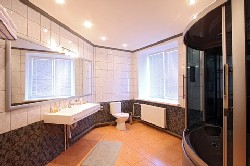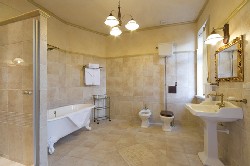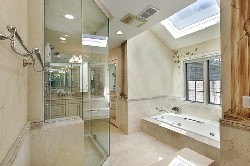Bathroom Ceiling Lighting: Using Ceiling Light To Create Warmth and Comfort
Bathroom ceiling lighting can make your entire bathroom more comfortable.
Bathroom ceiling lighting can solve one of the toughest problems in bathroom lighting. It is very easy for the task lighting in your bathroom to take over the entire room. This is especially true for the bright lights around the vanity. Instead, ceiling lights illuminate your entire bathroom, providing proper ambient lighting and a warm and intimate atmosphere. Proper lighting provides not only balance but also texture, as one-sided lighting makes everything look flat.
Using Color
The best color for bathroom ceiling lighting is almost always a warm light. Warm colors flatter people’s skin tones and provide an over all feeling of comfort, both of which are important to setting the right mood for a bathroom. (Of course, if warm colors somehow clash with the rest of your décor, you should use a cooler color).

Fluorescent lights now come in a wide array of colors, from the traditional cool whites to warmer colors.
Incandescent and halogen lights are both in the warm range of lights (2800º-3500º K), and you can also use fluorescents that have been colored so that they shine light within that range. Just beware of traditional fluorescents that will provide a much cooler light.
You’ll need to be careful, though, not to upset the bathroom vanity lighting too much with your ceiling lights. The warmth of light is very important to the application of makeup, so, if you’ve chosen to use a cooler light for applying makeup, make sure that your ceiling lights do not disrupt the coloration too much.
Using Recessed Ceiling Lighting
One of the most common types of bathroom ceiling lighting, especially in large bathrooms, is to include recessed lighting fixtures around the bathroom. As with most recessed lighting, you should ensure that you follow the specifications on the fixtures with respect to recessed lighting spacing.

Using recessed lighting spreads the light around your bathroom and takes focus away from the vanity.
When using recessed ceiling lighting, there are two places that you should be careful not to light directly. Be sure that you do not put a fixture directly above the sink. There are two reasons for this. First, it provides downlighting on people’s faces, which makes them look older and complicates shaving and the application of makeup. Second, the vanity is already brightly lit from its own lights and doesn’t need any help.
The other place you should not light directly is right over the head area of the bathtub. This is a very common mistake in bathroom ceiling lighting. When people take baths, they want to lean back and look upwards, but a light right above their head creates glare and makes this uncomfortable.
No matter how you use it, recessed lighting should not be your only source of illumination for your bathroom. Recessed lighting creates harsh shadows on people’s faces when used alone. Therefore, unless your bathroom is very small and the vanity will provide enough crosslight to counter the effect, you should be sure you have at least one additional source of lighting.
Using Pendant Lighting
One attractive option for bathroom ceiling lighting is the use of a pendant light, which provides soft, general illumination to the rest of the room. Pendant lights are mostly decorative and, because they do not only shine straight downward, they do not create the harsh shadows created by recessed lighting.

Overtaxing a central fixture creates the “glare bomb” effect, an uncomfortably bright source of light that makes the rest of the room look dark.
Instead of creating a glare bomb, there are two choices for proper use of pendant lighting in your bathroom:
First, you can have the pendant light only pretend to light the entire room. This is a common trick for preventing glare bombs in dining rooms and foyers. Use a number of other, hidden light sources, such as recessed lighting or opaquely-shaded sconces, to provide the room’s actual lighting.
Second, you can use the pendant light as an uplight. How this works is that you choose a pendant light with an opaque or translucent shade on the bottom that is white or reflective on the inside. Then, the light from the pendant is reflected onto your ceiling. This creates a soft, ambient light that can fill your entire space in a small room or that can be supplemented by other sources in a large one.
Using Solar Tubes (Skylights)
Solar tubes are anther attractive option for bathroom ceiling lighting, especially for lighting the bathing area. They help increase the amount of precious natural light, illuminating your space and reducing energy costs.

This skylight maximizes the amount of natural light over the bathtub.
One popular place for a solar tube is directly above the bath. During the day, anything that does not receive daylight from the windows will look enshadowed. As a result, a solar tube above the bath brightens the bathing area, making it far more relaxing.
As with any solar tube, it is best not to use clear glass on the tube, as this creates a window-shaped light that moves across your bathroom, literally burning away a line through your finishings over time. Instead, use a frosted, UV-protectant covering for the sake of both privacy and diffusion of light. If you do wish to create warmer light, a slight tint to this coloring can warm the color of the light coming through the solar tube.
At night, solar tubes can look very odd, like a big hole in your ceiling. This can be easily rectified by placing two or more small lights in the tube. These lights can even be solar powered, cutting down on your energy costs. This way, you can continue to use the tube even at night, and provide your bathroom with a warmer light when no sunlight is available.
Putting It Together
Bathroom ceiling lighting can be an important part of any bathroom lighting design. When used properly, it can:
- Offset the bright lights from the vanity.
- Provide ambient lighting for the entire room.
- Warm or cool your overall light as needed.
- Maximize the amount of precious sunlight in your bathroom.
We are fortunate to live in a time when the bathroom is no longer simply seen as a functional space.
Back from Bathroom Ceiling Lighting to Bathroom Lighting Design